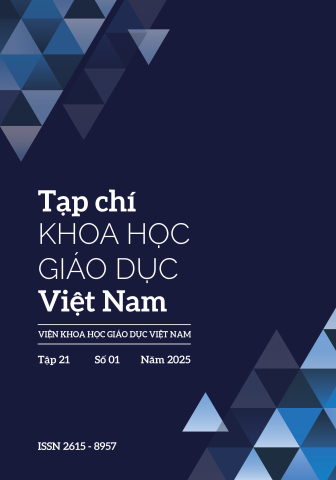[1] Al-Saadi, H. M. (2011). From spoon feeding to selffeeding: Helping learners take control of their own learning. Arab World English Journal, 2(3), 95- 114.
[2] Azzahfa, D. N., Bakhruddin, M., & Hayumuti. (2024). The Influence of Peers on Student Motivation. Tadrib: Jurnal Pendidikan Agama Islam, 10(1), Article 1. https://doi.org/10.19109/3vc1pp72.
[3] Bandura, A. (1977). Self-efficacy: Toward a unifying theory of behavioral change. Psychological Review, 84(2), 191–215. https://doi.org/10.1037/0033- 295X.84.2.191.
[4] Batistis, H. A., Paño, J. J., Revil, L. F., L Caga, S. S., T Eludo, D. R., B Lacaran, D., B Baldecir, K. R., C Benag, J. I., B Calinawan, J.-C., L Cadenas, J. A., & Lamanilao, R. P. (2024). Reasons behind students’ lack of participation in school activities: A Quantitative study. International Journal of Multidisciplinary Research and Growth Evaluation, 5(3), 804–811. https://doi.org/10.54660/. IJMRGE.2024.5.1.804-811.
[5] Brophy, J. (1983). Conceptualizing student motivation. Educational Psychologist, 18(3), 200-215.https:// www.tandfonline.com/doi/abs/10.1080/00461528 309529274.
[6] Carrington, V., Rowsell, J., Priyadharshini, E., & Westrup, R. (Eds.). (2016). Generation Z: Zombies, Popular Culture and Educating Youth. Springer Singapore. https://doi.org/10.1007/978-981-287- 934-9.
[7] Cayubit, R. F. O. (2022). Why learning environment matters? An analysis on how the learning environment influences the academic motivation, learning strategies and engagement of college students. Learning Environments Research, 25(2), 581–599. https://doi.org/10.1007/s10984-021-09382 -x.
[8] De La Croix, A., & Veen, M. (2018). The reflective zombie: Problematizing the conceptual framework of reflection in medical education. Perspectives on Medical Education, 7, 394 - 400. https://doi. org/10.1007/s40037-018-0479-9.
[9] Dung, N. V. H., & Duyên, T. T. N. (2020). Researching on “zombie leaner” syndrome of students of faculty of international studies, University of Foreign Language studies-the University of Danang. Tạp chí Khoa học và Công nghệ-Đại học Đà Nẵng, 55- 60. https://www.neliti.com/publications/450423/ researching-on-zombie-leaner-syndrome-ofstudents-of-faculty-of-international-st.
[10] Filgona, J., Sakiyo, J., Gwany, D. M., & Okoronka, A. U. (2020). Motivation in Learning. Asian Journal of Education and Social Studies, 16–37. https://doi. org/10.9734/ajess/2020/v10i430273.
[11] Földi, F., Szabó, N., Oo, T. Z., Csizmadia, G., & Józsa, K. (2024). Motivation in Learning Musical Instruments: The Role of Parents, Teachers, and Friends. Music & Science, 7, 20592043241284822. https://journals.sagepub. com/doi/10.1177/20592043241284822.
[12] Harden, R. M. (2007). Learning outcomes as a tool to assess progression. Medical Teacher, 29(7), 678–682. https://doi.org/10.1080/01421590701729955
[13] Harris, J. R. (1995). Where is the child’s environment? A group socialization theory of development. Psychological Review, 102(3), 458–489. https://doi. org/10.1037/0033-295X.102.3.458
[14] Hennessey, B. A. (2015). Reward, task motivation, creativity, and teaching: Towards a cross-cultural examination. Teachers College Record, 117(10), 1-28. https:// psycnet.apa.org/doi/10.1177/016146811511701007.
[15] Hornby, G., & Kauffman, J. (2023). Special education’s zombies and their Ibrahim, W., Ibrahim, W., Zoubeidi, T. et al (2022). An Online Management System for Streamlining and Enhancing the Quality of Learning Outcomes Assessment. Educ Inf Technol 27, 11325–11353. https://doi.org/10.1007/s10639- 022-10918-8.
[16] Ismail, A., & Zainun, Z. (2023). Confidence Level of College Students’ Learning Activity at University. Scaffolding: Journal Pendidikan Islam Dan Multikulturalisme, 5(1), 536-551. https://doi. org/10.37680/scaffolding.v5i1.2703.
[17] Kauffman, J. M., & Hornby, G. (2022). Special education’s zombies and their consequences. Unpublished Article, December. https://doi.org/10.1111/1467- 9604.12451.
[18] Kaveh, M. H. (2010). Motivation and learning. Interdisciplinary Journal of Virtual Learning in Medical Sciences, 1(1), 23-29. https://ijvlms.sums. ac.ir/?_action=xml&article=46027.
[19] Khan, S., Sadia, R., Zahid Hayat, S., & Tahir, S. (2019). Relationship between Academic Boredom, Learning Climate and Academic Motivation Among University Students. Pakistan Journal of Psychological Research, 34(3), 621–638. https://doi. org/10.33824/PJPR.2019.34.3.34.
[20] Lavy, V., Paserman, M. D., & Schlosser, A. (2012). Inside the black box of ability peer effects: Evidence from variation in the proportion of low achievers in the classroom. The Economic Journal, 122(559), 208-237. https://doi.org/10.1111/j.1468-0297.2011.02463.x.
[21] Nelson, R. M., & DeBacker, T. K. (2008). Achievement Motivation in Adolescents: The Role of Peer Climate and Best Friends. The Journal of Experimental Education, 76(2), 170–189. https://doi. org/10.3200/JEXE.76.2.170-190.
[22] Nwosu, K. C., Okoyoe, C. C., & Onah, U. H. (2018). An Interpretive Descriptive Study of Factors Affecting Academic Achievement of Underachieving Student Teachers in Nigeria. Journal of At-Risk Issues, 21(2), 20-29. https://eric. ed.gov/?id=EJ1199032
[23] Sambell, K., McDowell, L., & Montgomery, C. (2012). Assessment for learning in higher education. Routledge. https://doi.org/10.4324/9780203818268.
[24] Smith, K., & Hill, J. (2019). Defining the nature of blended learning through its depiction in current research. Higher Education Research & Development, 38(2), 383–397. https://doi.org/10.1080/07294360.2 018.1517732.
[25] Sweet, M., & Michaelsen, L. K. (2007). How group dynamics research can inform the theory and practice of postsecondary small group learning. Educational Psychology Review, 19, 31-47. https:// doi.org/10.1007/s10648-006-9035-y.
[26] Tandoc, E. C., Ferrucci, P., & Duffy, M. (2015). Facebook use, envy, and depression among college students: Is facebooking depressing? Computers in Human Behavior, 43, 139–146. https://doi.org/10.1016/j. chb.2014.10.053.
[27] Tucker, C. M., Zayco, R. A., Herman, K. C., Reinke, W. M., Trujillo, M., Carraway, K., ... & Ivery, P. D. (2002). Teacher and child variables as predictors of academic engagement among low‐income African American children. Psychology in the Schools, 39(4), 477-488. https://psycnet.apa.org/doi/10.1002/ pits.10038.
[28] Véronneau, M.-H., Vitaro, F., Pedersen, S., & Tremblay, R. E. (2008). Do peers contribute to the likelihood of secondary school graduation among disadvantaged boys? Journal of Educational Psychology, 100(2), 429–442. https://doi. org/10.1037/0022-0663.100.2.429.
[29] Wang, Zhan and Chen, Gaowei. “Chapter 4. Discourse performance in L2 task repetition”. Learning Language through Task Repetition, edited by Martin Bygate, John Benjamins Publishing Company, 2018, pp. 97-116. https://doi.org/10.1075/ tblt.11.04wan
[30] Wentzel, K. R. (1999). Social-motivational processes and interpersonal relationships: Implications for understanding motivation at school. Journal of Educational Psychology, 91(1), 76–97. https://doi. org/10.1037/0022-0663.91.1.76.
[31] Westrup, R. (2016). Students as Zombies: How Can We Awaken the Undead?. , 145-157. https://doi. org/10.1007/978-981-287-934-9_11.
[32] Whelan, A., Walker, R., & Moore, C. (2013). Zombies in the academy: Living death in higher education. Intellect. https://doi.org/10.2307/j.ctv36xw78w


